Abstract
The kinetics and mechanism of proton exchange between thiocarboxylic acids and o-substituted phenols with intramolecular hydrogen bonds (IMHB) were studied by dynamic PMR spectroscopy. Fast uncatalyzed exchange in cyclic binary complexes is observed for phenols with weak IMHB. In systems with strong IMHB fast exchange occurs only in the presence of an alkaline catalyst, the reaction of which with the phenol leads to cleavage of the IMHB. Concerted transfer of two protons and a cation is realized in the final step of the reaction. According to the proposed mechanism, the measured energy of activation of proton exchange is the sum of the energies of activation of the steps involving cleavage of the IMHB and strictly proton transfer.
Similar content being viewed by others
Literature cited
V. K. Pogorelyi and V. V. Turov, “Investigatron by NMR spectroscopy of fast proton exchange with the participation of thiocarboxylic acids,” Teor. Eksp. Khim.,16, No. 5, 643–648 (1980).
H. Ratajczak and W. J. Orville-Thomas (eds.), Molecular Interactions, Wiley, New York (1982).
H. Diebler, F. Secco, and M. Venturin, “Influence of intramolecular H bonding on Protontransfer reactions,” J. Phys. Chem.,88, No. 19, 4229–4232 (1984).
A. J. Kresge and M. F. Powell, “Mechanism of proton transfer from intramolecularly H-bonded acids. Differences between nitrogen-to-oxygen and nitrogen-to-nitrogen proton transfer,” J. Am. Chem. Soc.,103, No. 4, 972–973 (1981).
F. Hibbert and G. R. Simpson, “Mechanism of proton removal from intramolecularly H-bonded (phenyl-azo) resorcinol monoanions,” ibid.,105, No. 4, 1063–1064 (1983).
V. K. Pogorelyi and V. V. Turov, “Investigation of fast proton exchange between the SH groups of thiocarboxylic acids and triethylammonium (+NH) ions,” Teor. Eksp. Khim.,19, No. 6, 698–703 (1983).
V. N. Barvinchenko and V. K. Pogorelyi, “Investigation of the hydrogen bonds of thioacetic and chloroacetic acids with various electron donors,” ibid.,17, No. 6, 838–844 (1981).
H. S. Gutowsky and S. H. Hollm, “Rate processes and nuclear magnetic resonance spectra. 2. Hindered internal rotation of amides,” J. Chem. Phys.,25, No. 6, 1228–1234 (1956).
Author information
Authors and Affiliations
Additional information
Translated from Teoreticheskaya i éksperimental'naya Khimiya, Vol. 24, No. 1, pp. 49–56, January–February, 1988.
Rights and permissions
About this article
Cite this article
Pogorelyi, V.K., Barvinchenko, V.N. Effect of intramolecular hydrogen bonds on the kinetics of proton exchange of thiocarboxylic acids with phenols. Theor Exp Chem 24, 45–51 (1988). https://doi.org/10.1007/BF01392189
Received:
Issue Date:
DOI: https://doi.org/10.1007/BF01392189




